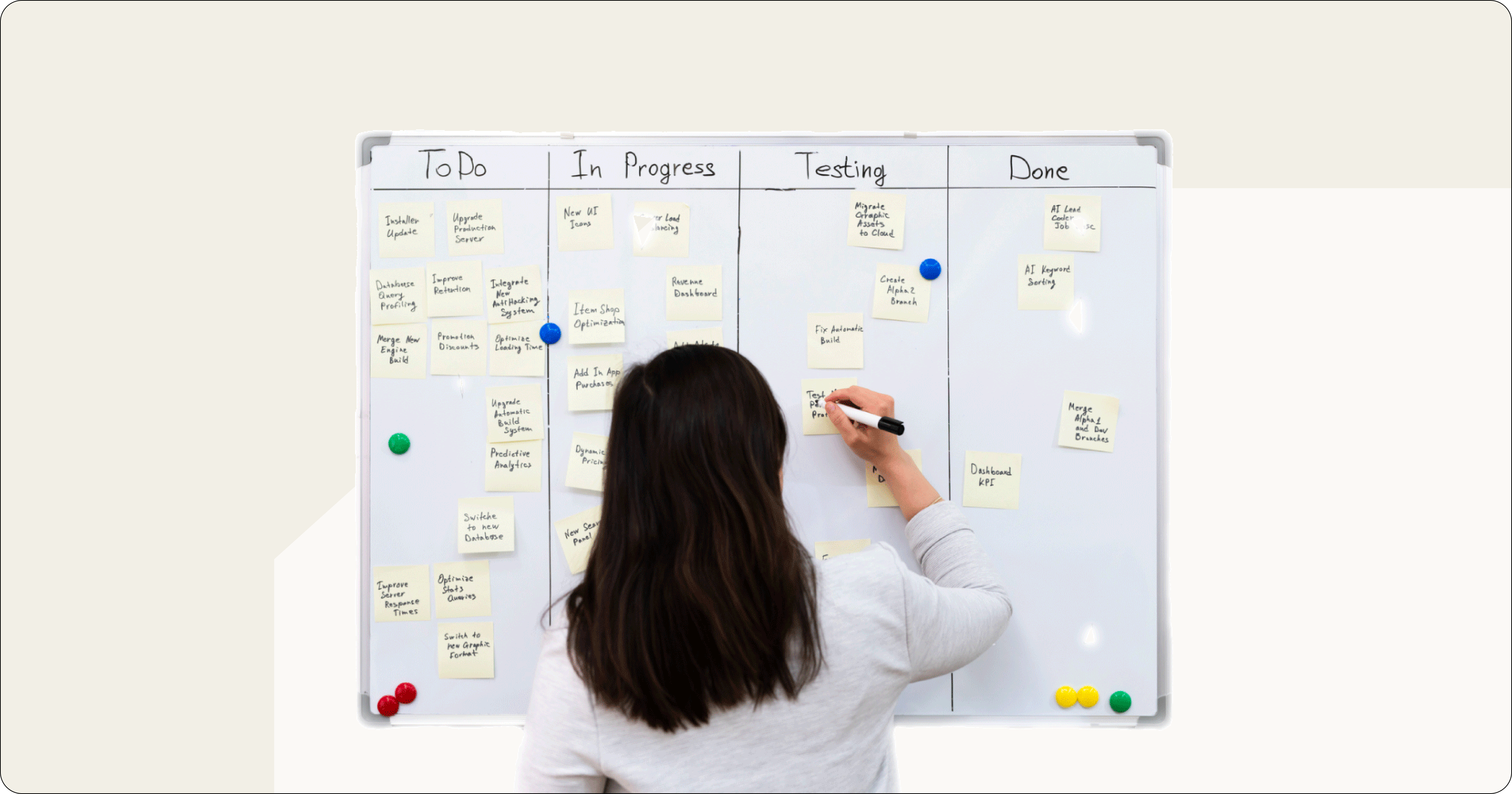Origins to Innovation: Cloud Computing's Impact on HR
Do you know why it's called cloud computing and are you aware of the benefits to HR?
- 06 Jun 2024
- Max 11 min read
The Number One HR Solution on Salesforce
Agile working is not just a buzzword, it's a game-changing approach to work that is transforming the way we do business. By embracing agile principles in your HR practices, you can unlock the full potential of your organization, making it more flexible and responsive to the ever-changing business environment. This iterative approach to HR not only speeds up problem-solving but also fosters a culture of collaboration and continuous growth – which is essential for success in today's fast-paced business world.
But to truly harness the power of agile HR, you need to understand the core concepts behind the Agile methodology, which include iterative planning, flexibility, collaboration, and continuous improvement. By incorporating these principles into your HR practices, you'll be better equipped to support your organization's goals and create a positive impact on both employees and business outcomes.
So, if you're ready to take your HR practices to the next level and drive success in your organization, it's time to embrace the power of agile working in HR, which will help create a culture of innovation that will set you apart from the competition.
Agile principles focus on flexibility, collaboration, responsiveness, and continuous improvement, fostering a more efficient and dynamic organization.
Agile working is an approach to work that emphasizes flexibility, collaboration, and responsiveness to change. It originated in the software development industry in the early 2000s as a response to traditional, rigid project management methods that were ill-suited to the fast-paced, constantly evolving nature of technology.
The Agile Manifesto, developed by a group of software developers in 2001, laid out the core principles of the approach and has since been adapted and applied to a wide range of industries. Agile working is characterized by iterative, incremental progress, frequent communication and feedback, and a focus on delivering value to the customer or end user.
Agile working in HR involves embedding the principles and practices associated with Agile methodologies into human resources management. This approach fosters a people-centric, responsive, and collaborative work environment. It requires HR teams to adopt a mindset that promotes adaptability and continuous improvement.
With agile HR, your HR processes can become more flexible and adaptable to change. It allows your HR team to be more proactive and able to respond quickly to emerging trends and challenges within the organization. This is particularly helpful in today's tech and AI-driven business environment, where companies and employees must constantly adapt to new tools and ways of working.
One key aspect of agile HR is the focus on the employee experience. Employees are seen as customers and users of various HR services, and HR teams work to provide a seamless experience that engages and delights employees. This focus on the employee experience is crucial to agile HR, as it fosters a culture of trust and collaboration within the organization.
Transitioning to agile HR involves rethinking your traditional HR processes and practices. For example, instead of annual performance reviews, agile HR can implement a continuous feedback cycle that allows employees and managers to evaluate and adjust performance on an ongoing basis. Additionally, HR teams can leverage data and analytics to identify trends and make informed decisions to drive the organization's growth. From talent acquisition to onboarding, there’s an opportunity to incorporate agile ways of working into all of your HR processes.
As well as increased employee engagement, improved responsiveness to change, and a more competitive edge in the market, embracing the Agile mindset in your HR practices will leave your team and organization well-prepared to thrive in a constantly evolving business landscape.

“As organizations become more digital, they face a growing imperative to redesign themselves to move faster, adapt more quickly, facilitate rapid learning, and embrace the dynamic career demands of their people.”
Experts have been advocating for the shift to agile working for years, as highlighted by the above excerpt from Deloitte's Human Capital Trends Report 2017. However, many organizations are still lagging behind. It's important to note that companies that have already embraced Agile methodology are reaping the rewards with increased success, profitability, and employee wellbeing. They have a competitive advantage over those that have not yet made the shift.
According to a study by McKinsey, agile teams reported a 30% increase in collaboration and a 40% increase in communication. Furthermore, companies that have successfully completed a digital transformation to adopt agile methods have been shown to outperform their peers financially. According to another McKinsey study, these companies were three times more likely to be top quartile financial performers than those that had not yet made the shift.
Adopting an agile HR model with its focus on responsiveness, collaboration, and improvement, can lead to more efficient and effective HR processes, and have a knock-on positive effect on organizational agility as a whole. Let’s take a look at how you might implement agile into some common HR processes:
An agile hiring process is designed to be flexible, collaborative, and efficient. It involves breaking down traditional silos and empowering cross-functional teams to work together to identify and attract top talent. Agile hiring teams prioritize speed and adaptability, often using data-driven insights and AI to inform their decisions. They may use tools such as applicant tracking systems, video interviews, and online assessments to streamline the process and reduce bias. Agile hiring also involves continuous feedback and improvement, with regular retrospectives to evaluate the effectiveness of the process and make necessary adjustments.
Agile methodology can be applied to OKRs (objectives and key results) and goal setting by emphasizing transparency, collaboration, and adaptability. Agile teams work together to set ambitious but achievable goals, using data to inform their decisions and track progress. They break down complex goals into smaller, more manageable tasks, and regularly evaluate their progress to identify areas for improvement. Agile teams also prioritize communication and feedback, with regular check-ins and retrospectives to ensure everyone is aligned and working towards the same objectives. This approach allows organizations to quickly adapt to changing business needs and stay focused on achieving their goals.
Agile onboarding emphasizes flexibility, collaboration, and rapid learning to help new employees integrate quickly and effectively into their roles and the organization as a whole. It involves breaking down traditional silos and empowering cross-functional teams to work together to support the new employee's transition. Agile onboarding teams prioritize speed and adaptability, often using data-driven insights to inform their decisions. They may use tools such as online training modules, video conferencing, and virtual mentors to streamline the process. Agile onboarding also involves continuous feedback and improvement, with regular check-ins and retrospectives to evaluate the effectiveness of the process and make necessary adjustments. This approach helps new employees feel supported and engaged from day one, leading to increased job satisfaction, productivity, and retention
As you can see, agile HR is helping organizations and their workforce prepare for the rapid changes in our technology-driven world. By implementing agile practices, your HR team can develop business agility, better align itself with organizational goals and add value at a faster pace.
Another key benefit to agile HR teams is improved talent and performance management. With Agile, your team members can optimize hiring, training, coaching, reviewing, and rewarding talent. This can lead to increased employee engagement, boosted morale, and higher retention rates.
Furthermore, agile practices can help HR departments enhance their own processes. By incorporating agile techniques, HR can become more responsive to the changing needs of your people and your organization.
Here are some advantages of adopting agile working in HR:
Implementing agile working practices in your HR department can lead to tangible benefits for your organization. By adopting agile, HR teams can become more responsive, better support employees, and contribute more effectively to the organization's overall success.
Traditional HR practices prioritize stability, policy compliance, and uniformity, with a top-down approach to decision-making. Roles are specialized, and change is often viewed with caution.
Agile HR represents a new way of thinking, emphasizing adaptability, flexibility, and rapid response to change. It promotes cross-functional collaboration, decentralized decision-making, and data-driven decisions for quicker, more effective responses to evolving business needs.
Despite its many benefits, organizations and individuals can be hesitant about switching to new workflows and systems. So consider this when introducing Agile methodology into your HR management strategy.
When implementing agile work practices in HR, you need to focus on change management. Embrace a test and learn approach, validating the value your people experience from it. Successful agile HR managers need to be intentional facilitators and coaches, guiding their teams throughout the process.
To successfully manage change, follow these steps:
Incorporate Agile methodologies into training and development programs. For example, use scrum as a learning framework where teams decide what they want to learn, set priorities, and conduct reviews and retrospectives. Here are some ideas to apply Agile practices to training and development:
Remember to adapt agile practices to your HR department based on your organization's needs and culture. Fostering an agile environment in HR will lead to a more efficient and adaptable department, ready to support your organization's goals and growth.
Agile working can have a significant impact on employee engagement, leading to several positive outcomes. By adopting an agile approach in your HR practices, you are enabling a flexible and dynamic work environment that can help boost employee satisfaction and productivity.
Organizations need to be able to quickly respond to changes in customer needs, market dynamics, and technology advances. By leveraging agile principles, you can empower your employees to embrace change and proactively contribute to continuous improvement. This can lead to a more proactive and engaged workforce.
Another advantage of agile working is its focus on collaboration and cross-functional teams. Employees are encouraged to work together, share ideas, and learn from each other, fostering a culture of open communication and trust. This can lead to a more committed workforce, who feel a sense of ownership and pride in their work.
Moreover, agile HR practices can also lead to more efficient talent management. Through agile methodologies, HR departments can prioritize and allocate resources for critical talent initiatives, ensuring a better alignment with business goals. As a result, you can ensure that your employees are properly supported, trained, and developed, which contributes to an increase in employee satisfaction.
Finally, agile working allows for increased transparency and feedback. With regular check-ins, performance reviews, and open communication channels, employees can have a better understanding of their performance and areas for improvement. This continuous feedback loop encourages employees to take ownership of their development and can lead to a more engaged and motivated workforce.
Through embracing the effective change management, collaboration, efficient talent management, and increased transparency that make up agile HR values, you can create a positive and motivating work environment that fosters employee commitment and satisfaction.

There are several real companies that have successfully embraced agile methodologies in HR. Here are a few examples for inspiration:
Vistaprint, a global e-commerce company, transformed its HR function using agile methodologies. The company renamed its HR function "Talent & Experience" (T&E) and reorganized its teams into cross-functional groups. T&E teams work collaboratively to identify and attract top talent, using data to inform their decisions. The company also implemented a continuous feedback and improvement process, with regular retrospectives to evaluate the effectiveness of the T&E function.
BBVA, a Spanish multinational financial services company, undertook an organization-wide role and resourcing redesign as part of an agile transformation. The company created functional agility via role specialization and centralized resourcing, breaking down silos and empowering cross-functional teams. BBVA also implemented a continuous feedback and improvement process, with regular retrospectives to evaluate the effectiveness of the agile transformation.
Spotify, a global music streaming service, has embraced agile methodologies in its HR function. The company uses agile principles to support its employee experience, including continuous feedback and improvement, cross-functional collaboration, and data-driven decision-making. Spotify also uses agile methodologies to support its recruitment process, using data to identify top talent and streamline the hiring process.
These companies have demonstrated that Agile methodologies can be successfully applied to HR functions, resulting in improved talent management, increased employee engagement, and better business outcomes.
Adopting an agile way of working in your HR functions can significantly enhance the value delivered to stakeholders, including end-users, employees, and customers.
Adopting agile working practices in HR can bring about significant benefits, but it also comes with its own set of challenges.
First, one of the major challenges you'll face is overcoming resistance to change, especially from traditional, old-system thinkers who may be apprehensive about adopting a new way of working. Convincing your team that agile practices are worth implementing may require demonstrating the benefits and establishing a clear roadmap for the transition. It's essential to keep communication lines open and address any concerns or doubts your team may have during the process.
Another challenge is ensuring that your HR team has the required skills and competencies to effectively implement agile practices. Developing these skills may necessitate a significant investment in training and development programs to equip your team with the knowledge and tools needed to succeed. This could include workshops or certifications in agile methodologies, as well as ongoing coaching and support.
Integrating agile practices into your existing HR processes can be complex and time-consuming, especially if your organization has deeply ingrained traditional work structures and policies. This might require you to reevaluate and revise various aspects of your HR function, from performance management systems to job descriptions and organizational design. It's crucial to approach these changes one step at a time, prioritizing the most critical aspects first and iteratively adapting as you learn from experience.
Finally, maintaining an agile mindset requires a shift in the organizational culture to embrace flexibility, learning, and continuous improvement. This could mean moving away from some long-held beliefs and practices, or adhering rigidly to hierarchical structures. Developing a culture that supports agile working in HR will take time and effort, but it's an essential component of successfully implementing this approach throughout your organization.
Transitioning to agile working in HR presents a range of challenges, but by being aware of these potential roadblocks and planning for them proactively, your HR team can successfully navigate the transition to agile working and reap its many benefits.
To assess the effectiveness of agile work practices in your HR department, you need to establish clear performance indicators and track them over time. Here are a few key metrics that can help you gauge the success of your agile HR initiatives.
1. Time to hire: One of the pivotal goals of agile HR is to shorten the hiring process, allowing your organization to fill open positions quickly. Monitor the time it takes from the initial job posting to a candidate's acceptance of an offer. A decrease in the time-to-hire metric signals that your agile methods are positively affecting the recruitment process.
2. Employee engagement: Agile HR practices are designed to foster a more adaptable, collaborative work environment. Use employee engagement surveys and feedback sessions to measure the change in employee sentiment. Higher engagement levels indicate that your agile HR strategy is creating a positive impact on your workforce.
3. Talent retention: Agile HR aims to create a more responsive and supportive work culture, which can lead to better talent retention. Track voluntary turnover rates across different departments, as a decrease in turnover rates suggests that employees are more satisfied with their work environment and agile HR practices.
4. Productivity and performance: Implement performance metrics to measure the impact of agile HR practices on productivity. These metrics can cover various aspects such as the completion of projects on time, the quality of work, and overall employee efficiency. Improved productivity rates indicate that agile HR methodologies are driving better results in your organization.
Remember, it's essential to analyze these metrics together in order to get a comprehensive understanding of the success of your agile HR initiatives. Continuously monitor and refine your agile practices to ensure that they bring about improvements in your organization.

As you adapt to the dynamic world of work, embracing agile methodologies in your HR functions has become increasingly important. By adopting an agile HR approach, your organization can allocate resources to top business needs, deliver critical talent initiatives faster, and achieve better outcomes.
In recent years, European and UK companies have been at the forefront of agile HR, with a growing interest and adoption in regions like the EU, UK, and Australia. This trend is expected to continue and expand to other parts of the world, including the US, as more HR professionals recognize the benefits of agile HR in 2022 and beyond.
As organizations continue to embrace Agile methodologies in HR, there are several upcoming trends that are expected to shape the future of agile HR. One of the most significant trends is the increasing use of data and analytics to inform HR decision-making. Agile HR teams are using data to identify trends, track employee performance, and make data-driven decisions about talent management. This approach allows HR teams to be more proactive, identifying potential issues before they become problems and making informed decisions that benefit both employees and the organization.
Another trend is the increasing use of technology to support agile HR processes. Agile HR teams are using tools such as AI chatbots, virtual reality, and artificial intelligence to streamline talent management processes, reduce bias, and improve the employee experience. For example, chatbots can be used to answer employee questions, while virtual reality can be used to provide immersive onboarding experiences. Artificial intelligence can be used to analyze data and identify patterns, helping HR teams make more informed decisions about talent management.
Finally, there is a growing trend towards employee empowerment in agile HR. Agile HR teams are empowering employees to take ownership of their own development, providing them with the tools and resources they need to succeed. This approach involves creating a culture of continuous learning and development, where employees are encouraged to take risks, learn from failure, and collaborate with their peers. By empowering employees in this way, agile HR teams are able to create a more engaged, motivated, and productive workforce, driving business success in the long term.
As your organization adopts agile methodologies in HR, remember to keep the focus on employee experience, ensuring their needs are considered and addressed throughout the agile transformation. This continuous growth and improvement not only benefit your business but also lead to higher levels of employee engagement, satisfaction, and retention.
Adopting an agile way of working in your HR functions can significantly enhance the value delivered to stakeholders, including end-users, employees, and customers. Agile principles focus on flexibility, collaboration, responsiveness, and continuous improvement, fostering a more efficient and dynamic organization.
Implementing agility in HR is more than just incorporating kanban boards and stand-up meetings. By embracing a test-and-learn approach, you can deliver tangible value validated by your people's experiences. Applying agile values and principles to HR and business management can help you create better ways of working and improve employee experiences.
As you embark on this journey, remember that agile HR requires a shift in mindset within your organization. Moving away from rigid, traditional practices will enable your teams to better adapt to the ever-changing business landscape. Ultimately, this will lead to more innovative solutions and an overall enhancement in the quality of services provided. So embrace the agile philosophy and watch your HR function transform for the better!
Looking for the perfect partner to help you build and implement your agile HR strategy? Look no further than flair. Book a demo today and we’ll show you why flair is top of the class when it comes to tools for agile HR teams.
Join flair’s newsletter to receive the latest tips & trends in the HR world.

